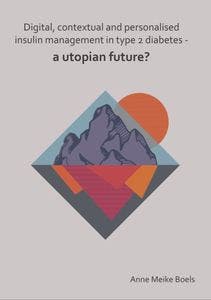Anne Meike Boels
Digital, contextual and personalised insulin management in type 2 diabetes - a utopian future?

- Datum
- (Co) promotoren
- 12-02-2019
- prof.dr. G.E.H.M. Rutten, dr. R.C. Vos
Samenvatting
Worldwide, there are 415 million people living with diabetes. Many of them need insulin therapy to achieve adequate blood glucose levels. Since a couple of years, there is consensus that ‘one-size-does-not-fit-all’ in this respect. We need to take a patient’s personal characteristics and context into account. This statement raises several questions, which we addressed in this thesis. First, we evaluated personalising treatment strategies in type 2 diabetes (T2DM) care. Second, we examined the association between insulin and patient-reported outcomes like treatment satisfaction. Finally we investigated the effectiveness of smartphone apps for T2DM patients According to the ‘one-size-fits-all’ approach, only one-in-four patients was cardiometabolic well-controlled. However, according to the personalised approach almost one-in-three people (32%) was well-controlled. By personalising the HbA1c (i.e. diabetes control) target for individuals >70 years, potential overtreatment could be prevented in one-in-four individuals. We could demonstrate that, five years before personalised treatment targets were formally advised, many physicians in Europe already applied such an approach. In Germany, Ireland, Sweden, the Netherlands, and the United Kingdom, physicians would initiate insulin for an older, complicated patient at higher HbA1c levels compared with a young, uncomplicated patient. Previous research has shown that individuals on insulin therapy are less satisfied with their diabetes treatment compared to individuals who do not use insulin. We also found that individuals on insulin therapy were less satisfied with their diabetes treatment when their actual or perceived diabetes control was worse. They were more satisfied with their diabetes treatment when they had received diabetes education, had a history of coronary or cerebrovascular complications or had a better health status. In another study we found no difference in patient activation between those individuals using or not using insulin therapy. We did however find that patient activation was associated with contextual factors such as educational level and social support. Finally, we found that individuals on insulin therapy had a worse health status and experienced more psychosocial stress, independently of diabetes duration, level of diabetes control and the number of diabetes related complications. Outcomes like treatment satisfaction, illness perceptions, health status, social support et cetera appear not only to be associated with clinical outcomes but also with each other. This complicated network of associations implies that contextual factors should be incorporated in T2DM treatment. Self-management is crucial in a patient’s lifelong handling of diabetes. We systematically reviewed and meta-analysed all available evidence worldwide on the effectiveness of automated mHealth interventions (mainly apps and text-messages) that provide diabetes self-management education and/or support. Their effect on diabetes control proved to be limited. In the randomised TRIGGER study we investigated the effect of diabetes education via a smartphone app in individuals with T2DM on insulin therapy. There was no effect of the TRIGGER app on the level of diabetes control, on the number of hypoglycaemic events, on treatment satisfaction nor on quality of life. Also for apps ‘one-size-does-not-fit-all’ holds true. To conclude, our studies emphasise the need for a shift in diabetes care, taking patient’s needs and preferences more seriously.
